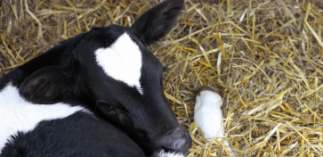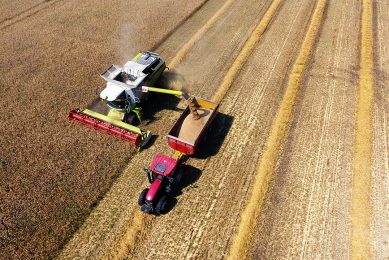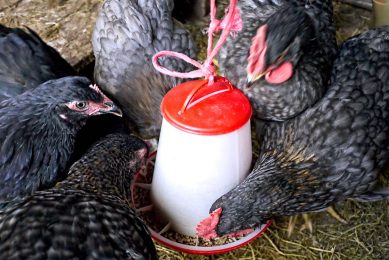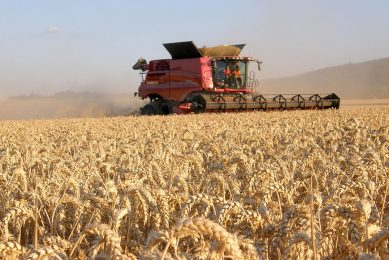Lactoferrin supplementation for calves (Part 1)

Lactoferrin is a naturalanti-oxidant and supports the immune system among others. This makes it an ideal supplement for calves. In this first article of a two part series we review the positive effects of lactoferrin supplementation. By Mascha Abrahamsen and Johan Lemmen from Nutrifeed.
Lactoferrin is a glycoprotein present in milk and secretions of mucous membranes such as saliva, tears, hepatic bile and pancreatic fluids (Steijns and van Hooijdonk, 2000).
Lactoferrin is isolated from the milk by a process known as chromatographic separation. A component can bind under specific conditions with a solid carrier (charge interaction for example). After fixation the specific component can be removed by flushing the carrier with a solution which contains a substance which has a higher affinity for the carrier.
The protein lactoferrin has under normal pH conditions of whey or milk a positive charge. The other proteins are negatively charged. The lactoferrin has a high affinity for the negatively charged resin. During the loading phase large volumes of whey/milk pass through the resin to achieve saturation.
The second step is to remove the lactoferrin from the resin, this is performed by a specific saline solution which has a higher affinity for the resin than the lacto-ferrin. The lactoferrin is concentrated in the saline solution (500 times higher than in whey/milk). The next step is ultra filtration of the saline solution which separates the lactoferrin from the saline. The concentrated lactoferrin solution is spray dried. Lactoferrin is already applied in infant formulas, sport drinks and functional foods, personal care products, veterinary and feed specialities for a number of interesting functional properties.
Indirect functions
Lactoferrin is present in very high concentrations in colostrum (1000 ppm). Lactoferrin plays a role in iron transport, is a natural anti-oxidant, supports the immune system and protects against micro organisms. Given the high concentration in colostrum, it may also play an important role in iron nutrition, pre-immune innate defence as well as the development of the gut (Naidu, 2000). Calves are often born with low blood haematocrit and haemoglobin levels, which 0-negatively influence growth rate and health. Iron is a trace element and is insufficient in colostrum and in whole milk (1-4 mg/kg DM) to comply the iron requirements for calves (40-100 mg/kg dry matter intake). Therefore, calves are often treated with an iron supplement after birth. Supplemented lactoferrin, combined with iron, accelerates an iron shift in the blood soon after birth (Kume and Tanabe, 1996).
It is generally accepted that iron is an essential nutrient required to sustain production levels in livestock, such as growth and milk production. About 70% of body iron is present in haemoglobin in red blood cells and myoglobin cells in muscle. The other 30% is present in the liver, spleen and other tissues. Iron plays a role in enzymes involved in oxygen transport and in oxidative processes. In addition to physiological functions within livestock, iron plays a vital role as a co-factor in enzymatic processes within bacteria as well. It is recognised that depriving the pathogenic gastro-intestinal flora from iron, results in decreased growth of these specific bacteria. This has been documented for species as Escheria coli, Salmonella typhimurium, Shigella dysenteriae, Listeria Monocytogenes and Streptococcus mutans (Pakkanen, 1997).
Bacteriostatic properties
Lactoferrin is known to exert bacteriostatic properties predominantly based on the ability to bind iron. This is an indirect mode of action to inhibit the growth of the pathogenic flora in the intestine. There is also evidence indicating a direct bactericidal effect unrelated to iron binding. This is mediated by binding to the surfaces of susceptible organisms (Arnold et al, 1982). The interaction between lactoferrin and gram-negative bacteria releases lipopolysaccharides. This reduces outer membrane permeability and increases bacterial susceptibility to other antimicrobial factors. Besides the bacteriostatic properties, lactoferrin also demonstrates antiviral and antiparasitic activities (Naidu, 2000). In literature (Robblee et al., 2002) it was concluded that lactoferrin supplementation of 0, 1, 2 or 3 g/d increased average daily gains, decreased faecal scoring and reduced costs for veterinary medical treatments. Calves fed 1 g/d supplemental lactoferrin had a greater pre-weaning average daily gain compared to calves fed 0 or 10 g/d lactoferrin (Joslin et al., 2001).
Calves fed lactoferrin consumed more calf starter during the pre-weaning period. Determination of the effects of a combination of two bioactive peptides (lactoperioxidase and lactoferrin) in young calves is reported in the literature (Leeuwen, van et al., 2000). The results showed a significant reduction of diarrhoea, number of Escherichia coli in vivo and in faeces of the calves with the combination. The intestinal villi are also significantly better developed for an optimal digestion and optimal absorption of nutrients.
Lactoferrin for piglets Researchers from the Institute of Feed Science, Zhejiang University in China looked at the effect of lactoferrin on growth performance, on intestinal micro-flora and on intestinal morphology in piglets. They found out that lactoferrin supplementation improved growth performance, significantly increased the ADGby 34.0% and ADFIby 17.0%, decreased the F/Gby 12.8% and diarrhoea by 66.2%. The bad bacteria Escherichia coli and Salmonella in the intestines were reduced and the good bacteria Lactobacillus and Bifidobacterium were increased in the small intestine. Another study from the same Chinese confirmed the positive effects of dietary bovine lactoferrin on performance and antioxidant status of piglets. Results showed that supplementation with lactoferrin improved average daily gain (ADG), average daily feed intake (ADFI) and reduced diarrhoea ratios of piglets. results also indicated that the lactoferrin supplementation enhanced antioxidant enzymes activity and mRNAlevels of the piglets. |
Mascha Abrahamsen and Johan Lemmen are both nutritionist at the R&D department of Nutrifeed in the Netherlands. Nutrifeed is a FrieslandCampina company. In the next article we will discuss some recent studies that have been done in calves.
Source: Feed Mix magazine Volume 17. No. 3











